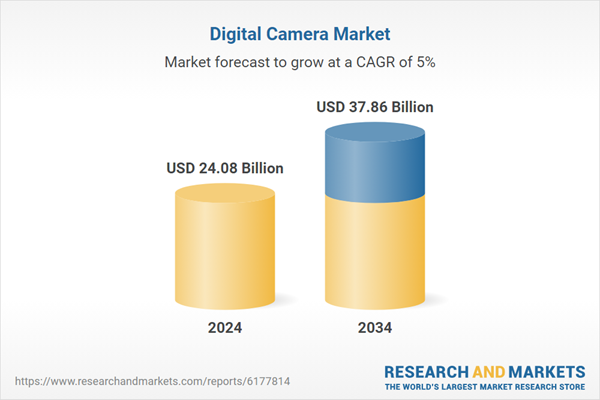Strong demand continues to fuel the market, as professionals and serious hobbyists increasingly seek high-resolution imaging tools that offer advanced optical performance. While smartphones dominate casual photography, digital cameras remain the preferred choice for tasks requiring interchangeable lenses, advanced sensors, and superior image clarity. The growth of content creation for social media, livestreaming, and digital marketing is widening appeal, particularly for mirrorless and compact action cameras. Simultaneously, usage in specialized fields such as medical imaging, industrial inspection, and scientific research is expanding, further diversifying demand. The adoption of advanced features like AI-enhanced autofocus, image stabilization, back-illuminated CMOS sensors, and 4K/8K video is encouraging upgrades across consumer and commercial segments. Meanwhile, falling prices for full-frame and mirrorless systems are reducing entry barriers, prompting more users to transition from older formats. This convergence of creative, professional, and industrial demand extends the digital camera market’s reach and resilience.
The interchangeable-lens camera segment was valued at USD 12.99 billion in 2024. These systems are favored for their adaptability, enabling users to swap lenses for varying environments from landscapes to close-up portraits and even cinematic video. The flexibility and image quality continue to attract both skilled professionals and aspiring content creators, reinforcing the segment's dominance across genres.
The DSLR cameras segment generated USD 7.52 billion in 2024. This category maintains a significant installed base, particularly among seasoned photographers and institutions that rely on optical viewfinders, durable construction, and an expansive legacy lens ecosystem. Despite a gradual decline in unit shipments, the segment retains relevance in fields like sports and nature photography, where tactile precision and mechanical reliability are essential.
U.S. Digital Camera Market was valued at USD 5.14 billion in 2024. It remains the leading contributor within North America, with strong adoption across professionals, creative influencers, and specialized industrial users. Demand for full-frame and mirrorless systems is particularly high due to the influence of filmmaking, content creation, and digital advertising. The popularity of outdoor and action-oriented lifestyles has also maintained steady interest in rugged, compact models. Brands are increasingly positioning their mirrorless models as compact yet pro-level tools, appealing to a broader consumer base. Collaborations with content platforms and flexible financing programs are enhancing product accessibility.
Prominent players in the Global Digital Camera Industry include Canon Inc., Fujifilm Holdings Corporation, Sony Group Corporation, Nikon Corporation, Panasonic Corporation (Lumix), GoPro, Inc., DJI (Shenzhen DJI Sciences and Technologies Ltd.), Olympus Corporation (OM System), Hasselblad, RED Digital Cinema, LLC, Insta360 (Arashi Vision Inc.), Sigma Corporation, Polaroid Originals, Leica Camera AG, LG Electronics, Blackmagic Design Pty Ltd., YI Technology (Xiaomi ecosystem), Samsung Electronics Co., Ltd., Drift Innovation Ltd., Sharp Corporation, Phase One A/S, Ricoh Imaging Company, Ltd. (Pentax), Eastman Kodak Company (Kodak), Logitech International S.A., and AKASO. Leading digital camera manufacturers are enhancing their global presence by investing in mirrorless and full-frame innovation, integrating AI and high-speed imaging capabilities. Many companies are diversifying their product portfolios to appeal to both professionals and content creators, while expanding into enterprise applications like surveillance and industrial vision. Strategic collaborations with social media platforms and creator communities have become vital for promoting adoption. Subscription-based services, flexible payment models, and bundled accessories are helping to attract entry-level users.
Comprehensive Market Analysis and Forecast
- Industry trends, key growth drivers, challenges, future opportunities, and regulatory landscape
- Competitive landscape with Porter’s Five Forces and PESTEL analysis
- Market size, segmentation, and regional forecasts
- In-depth company profiles, business strategies, financial insights, and SWOT analysis
This product will be delivered within 2-4 business days.
Table of Contents
Companies Mentioned
The companies profiled in this Digital Camera market report include:- Canon Inc.
- Fujifilm Holdings Corporation
- Leica Camera AG
- LG Electronics
- Nikon Corporation
- Olympus Corporation (OM System)
- Panasonic Corporation (Lumix)
- Ricoh Imaging Company, Ltd. (Pentax)
- Samsung Electronics Co., Ltd.
- Sigma Corporation
- Sony Group Corporation
- Blackmagic Design Pty Ltd.
- Hasselblad
- Logitech International S.A.
- Phase One A/S
- Polaroid Originals
- RED Digital Cinema, LLC
- Sharp Corporation
- AKASO
- DJI (Shenzhen DJI Sciences and Technologies Ltd.)
- Drift Innovation Ltd.
- GoPro, Inc.
- Insta360 (Arashi Vision Inc.)
- YI Technology (Xiaomi ecosystem)
Table Information
| Report Attribute | Details |
|---|---|
| No. of Pages | 195 |
| Published | September 2025 |
| Forecast Period | 2024 - 2034 |
| Estimated Market Value ( USD | $ 24.08 Billion |
| Forecasted Market Value ( USD | $ 37.86 Billion |
| Compound Annual Growth Rate | 5.0% |
| Regions Covered | Global |
| No. of Companies Mentioned | 25 |









